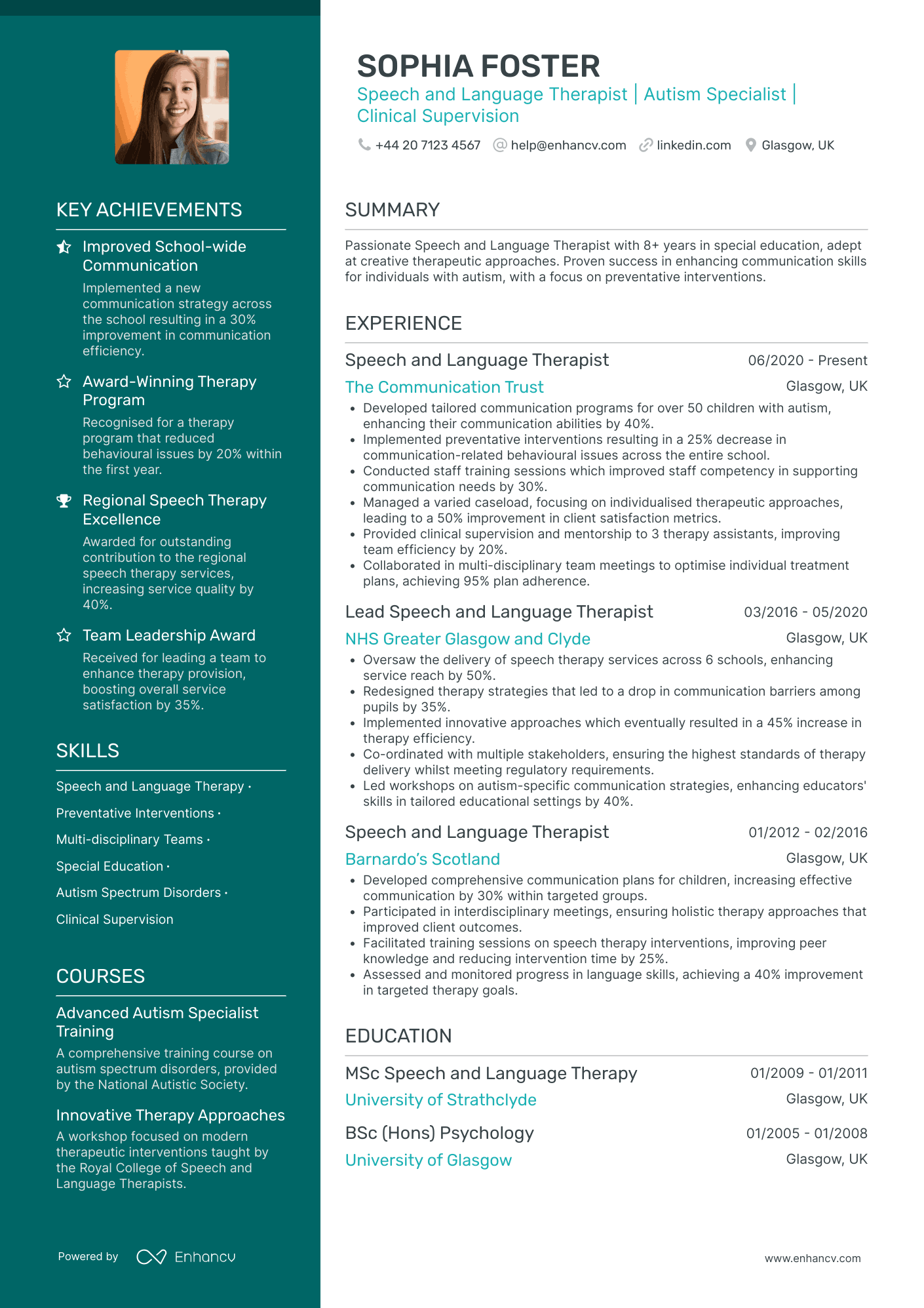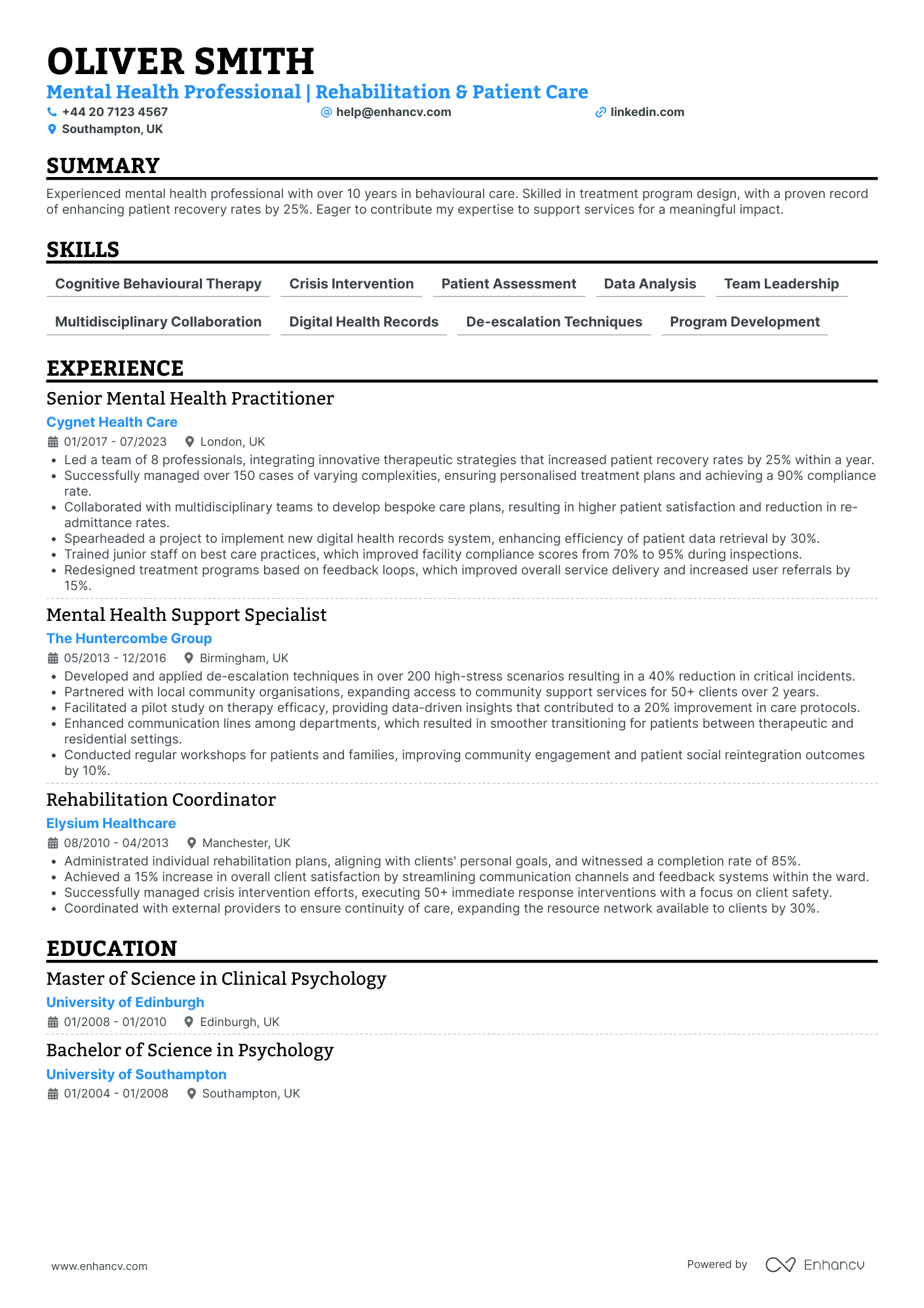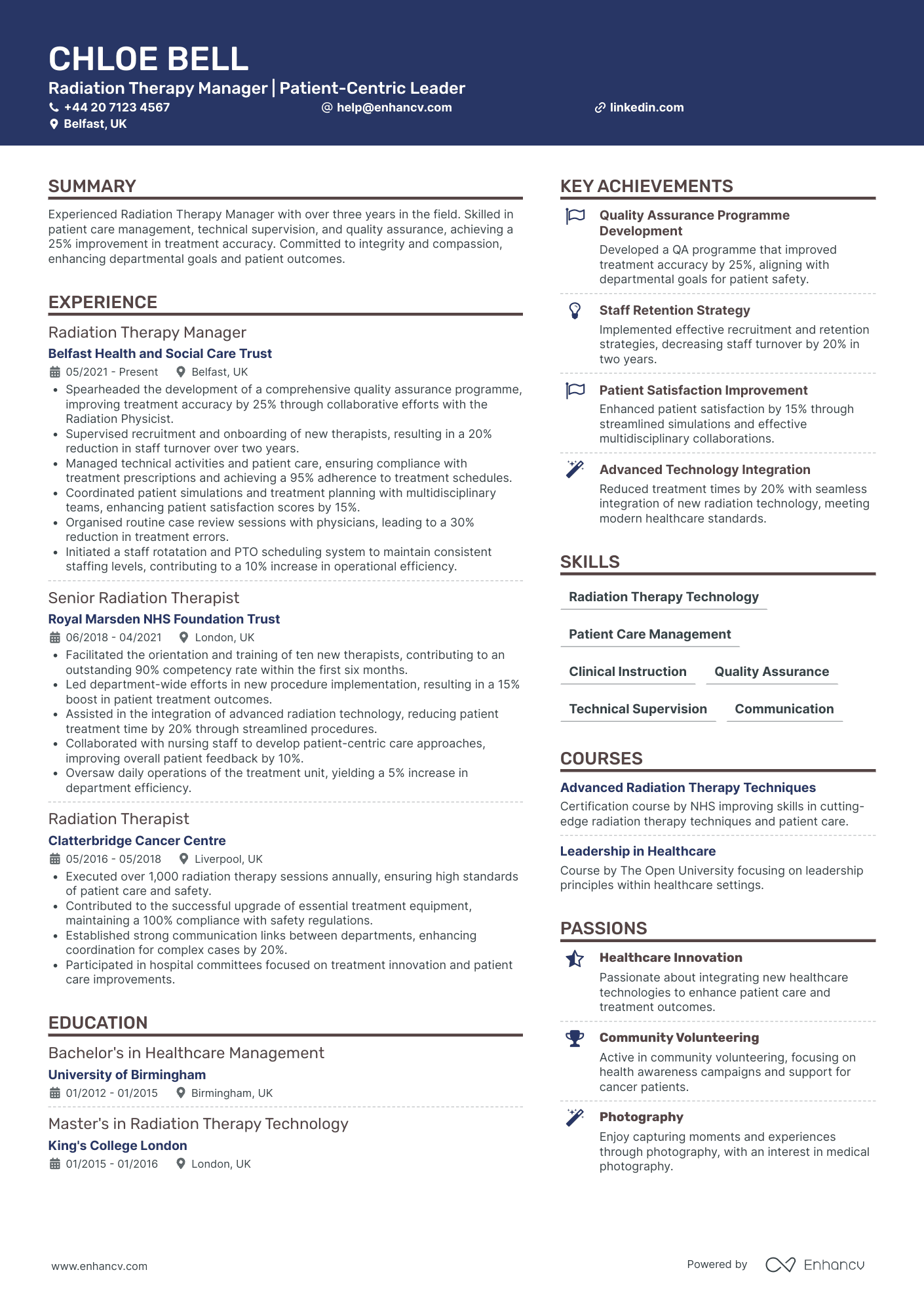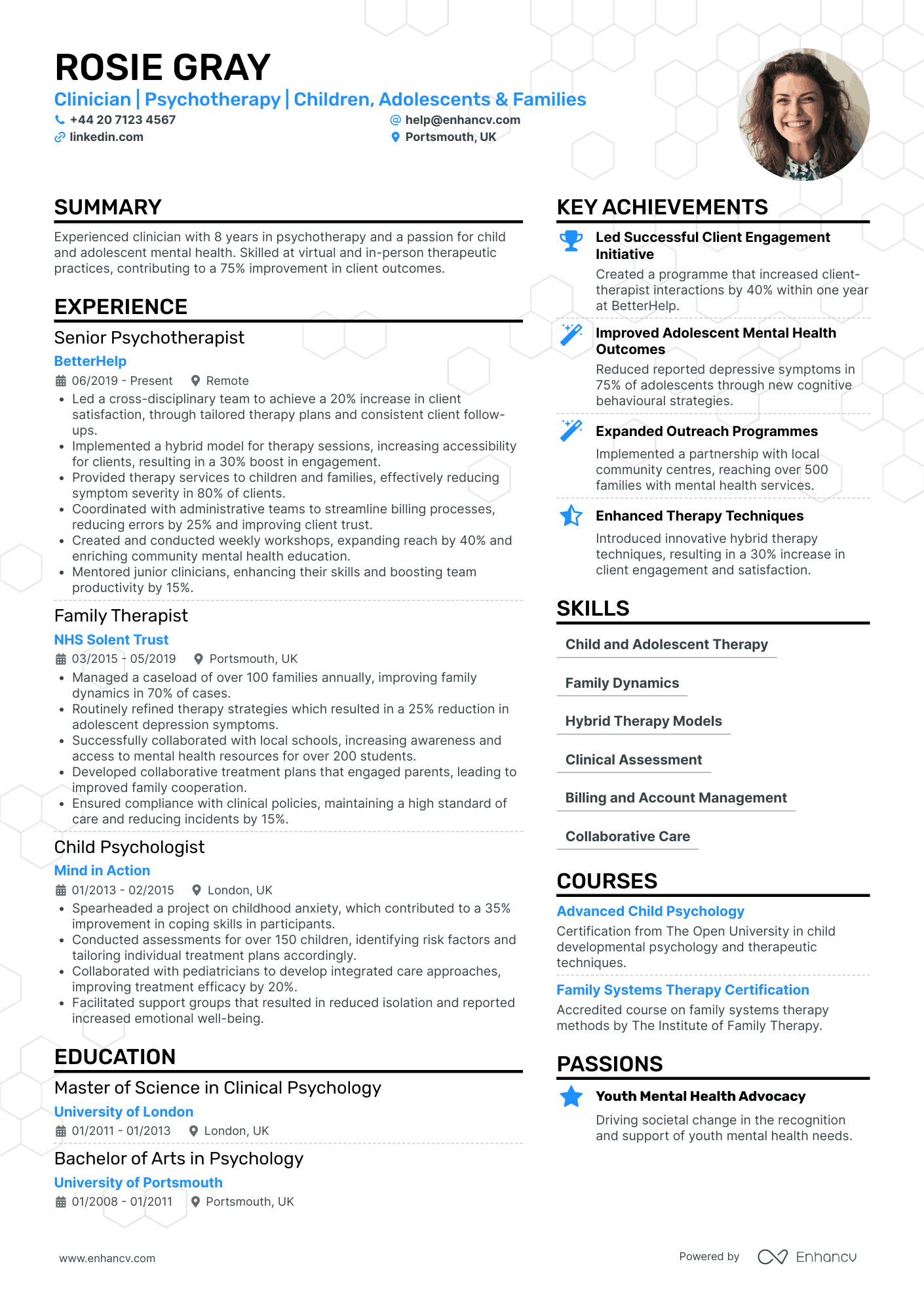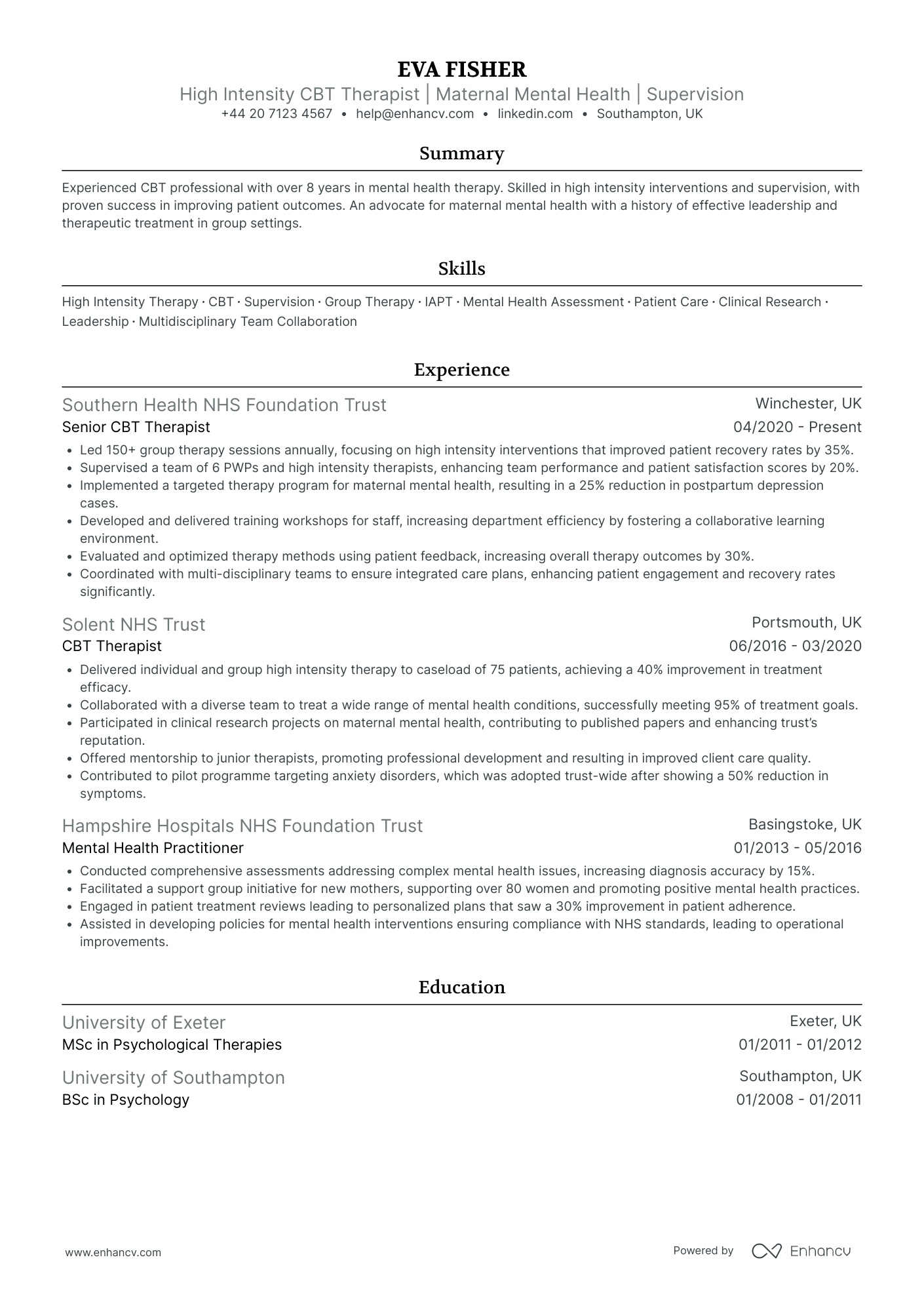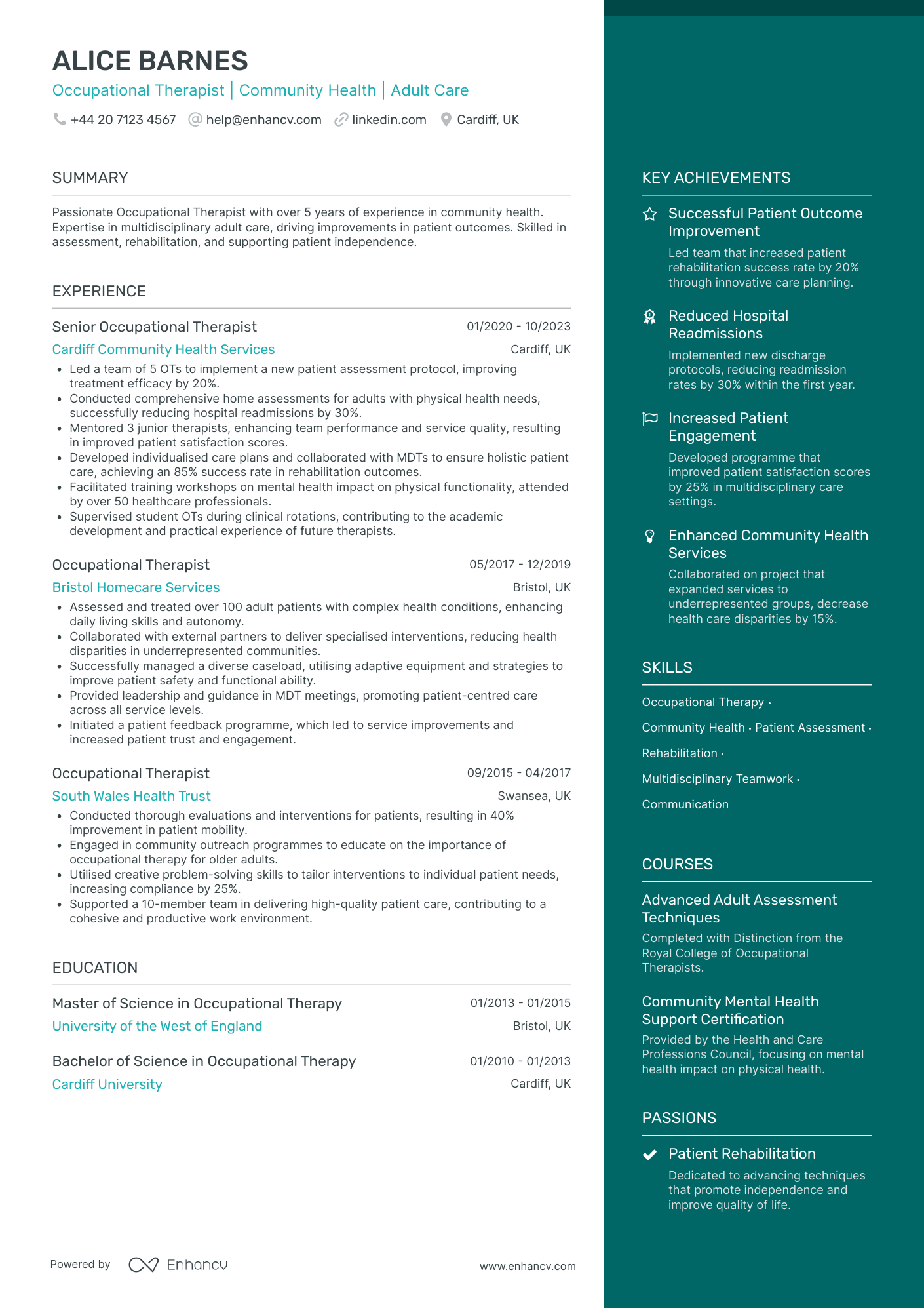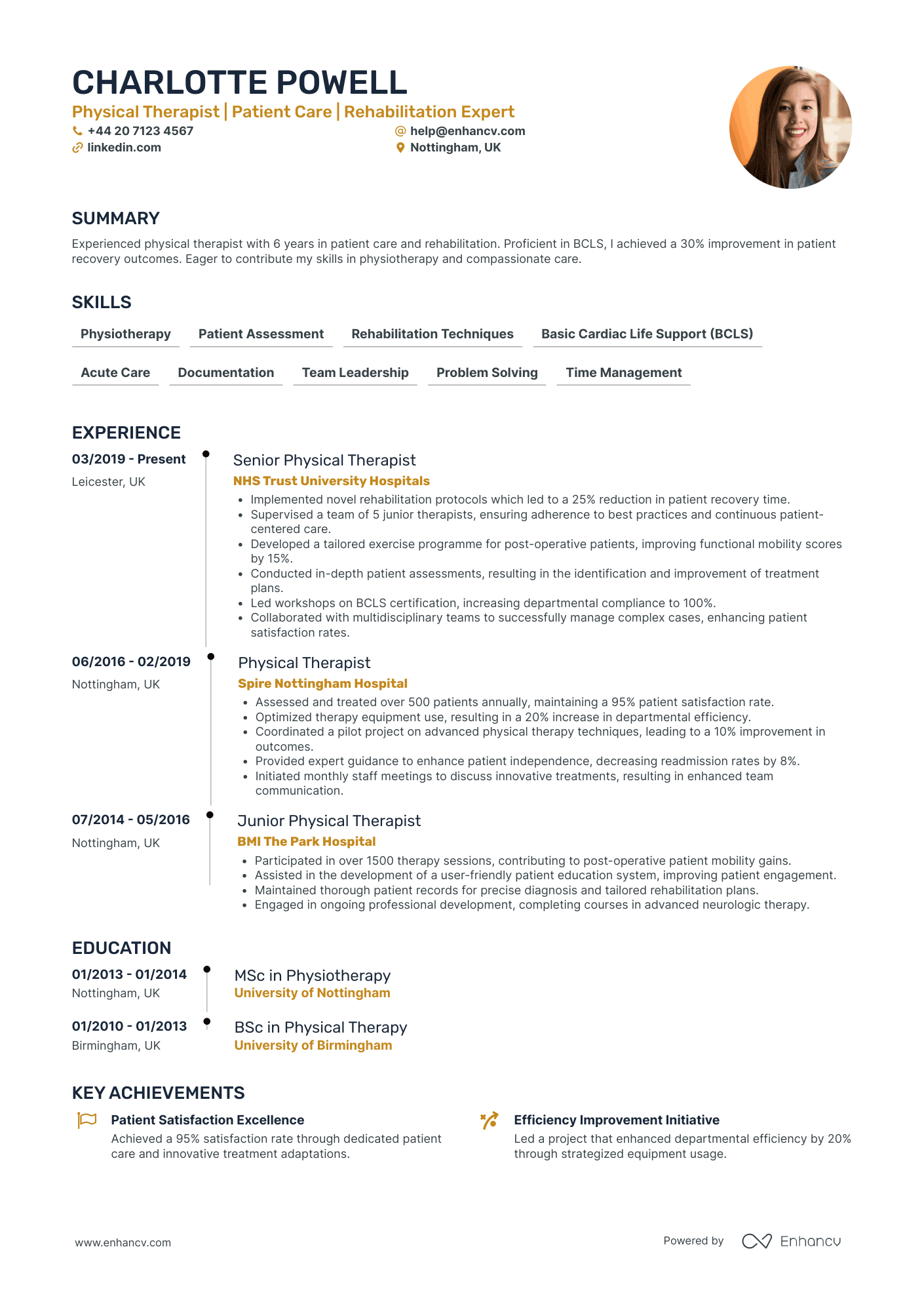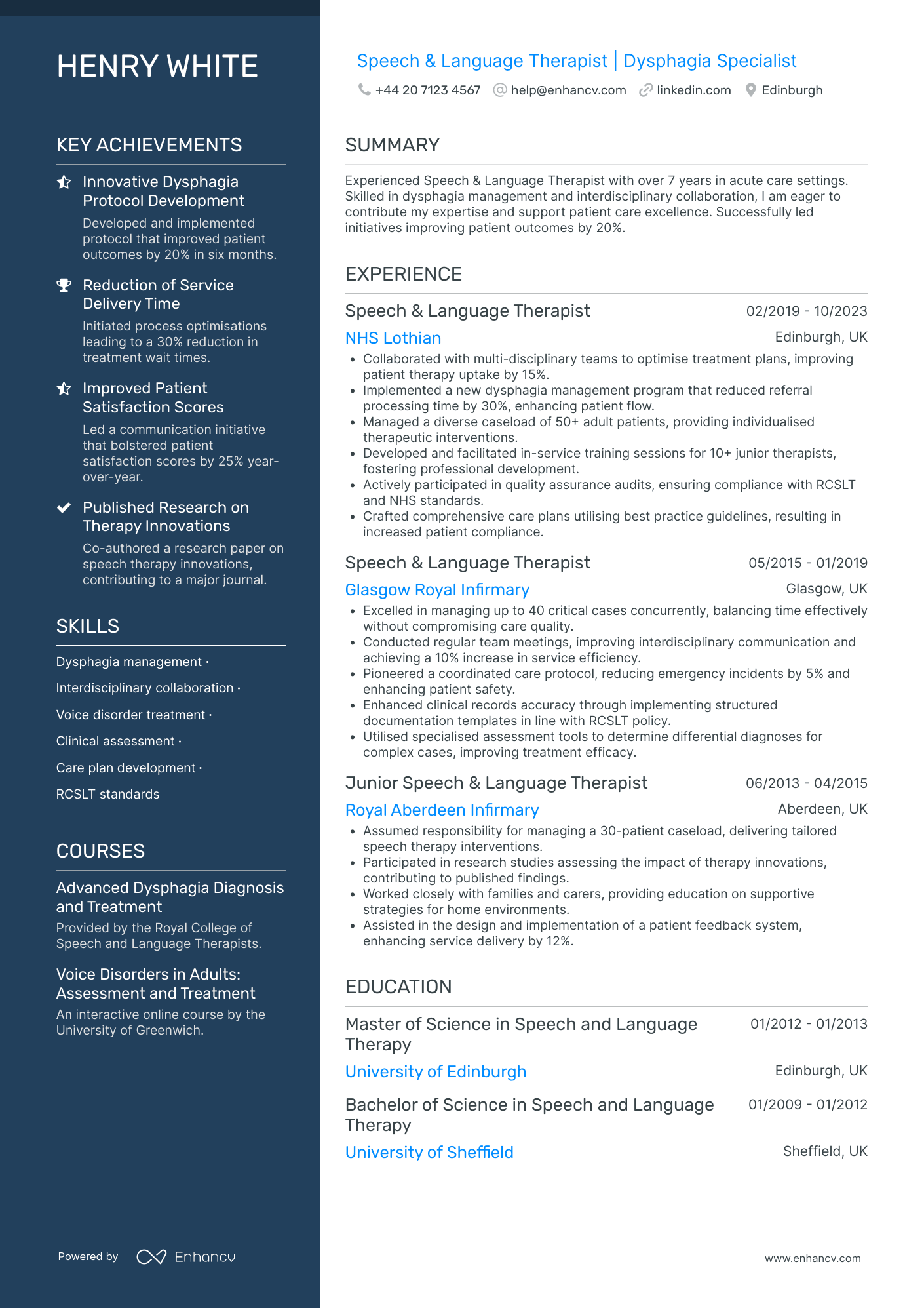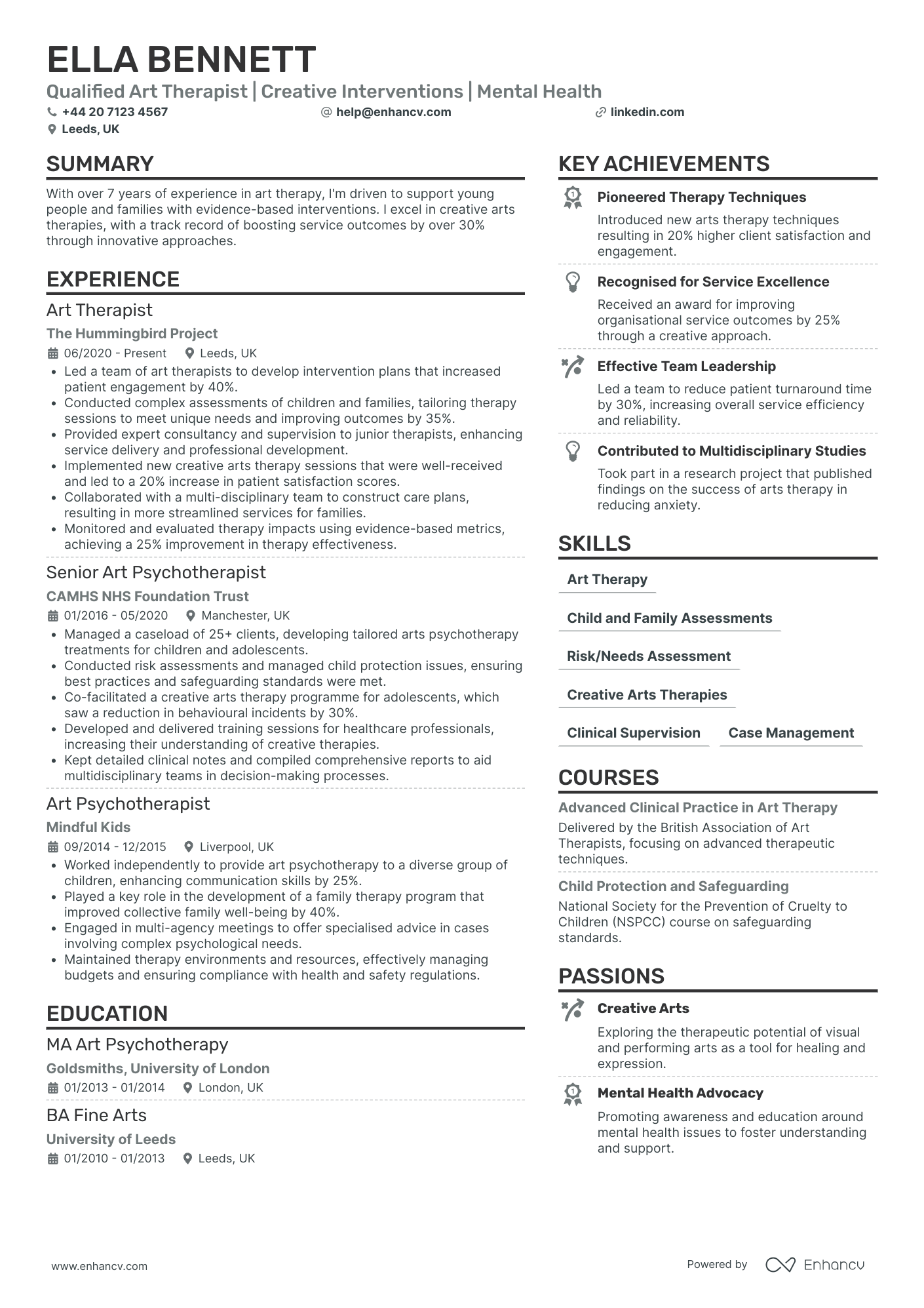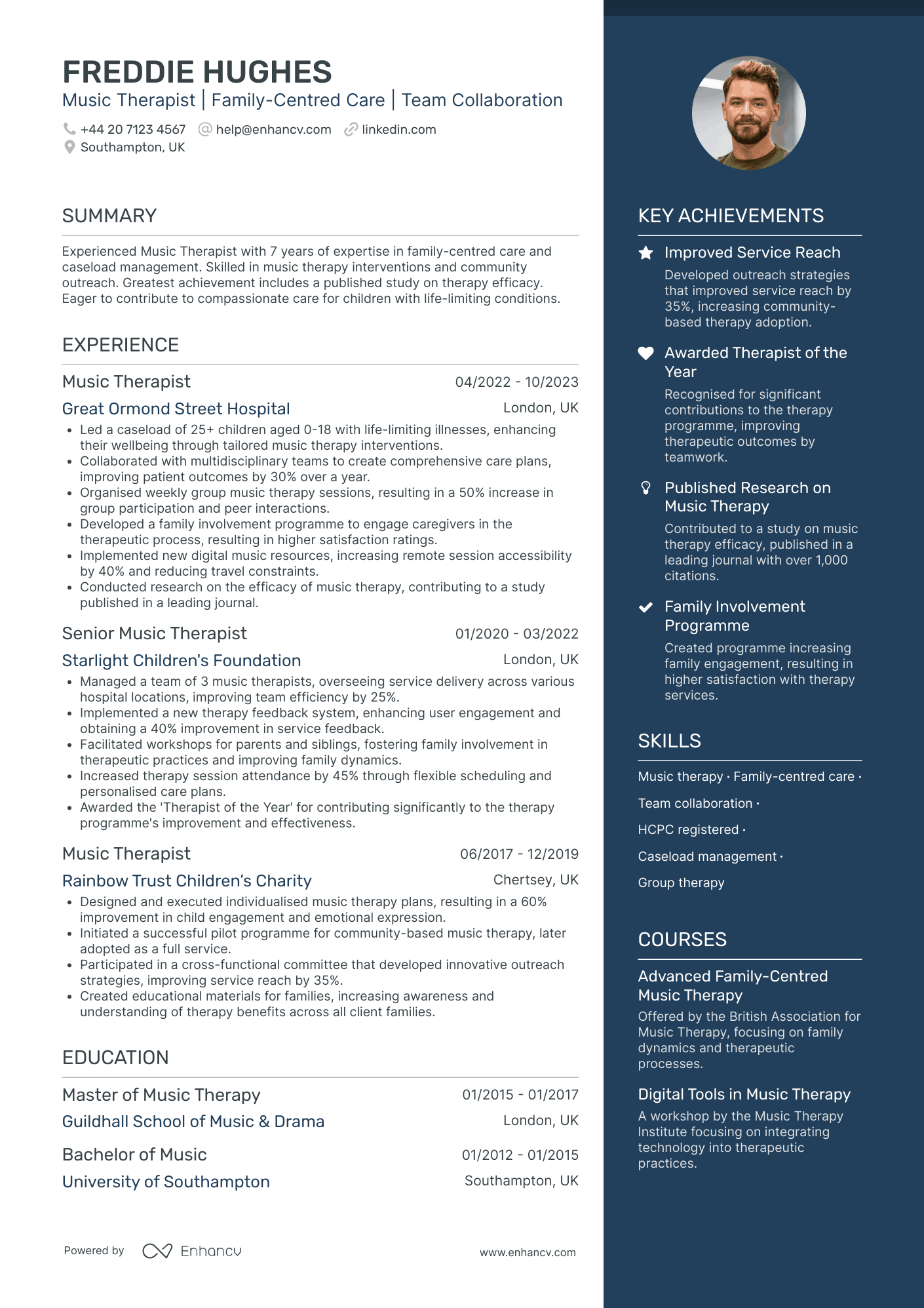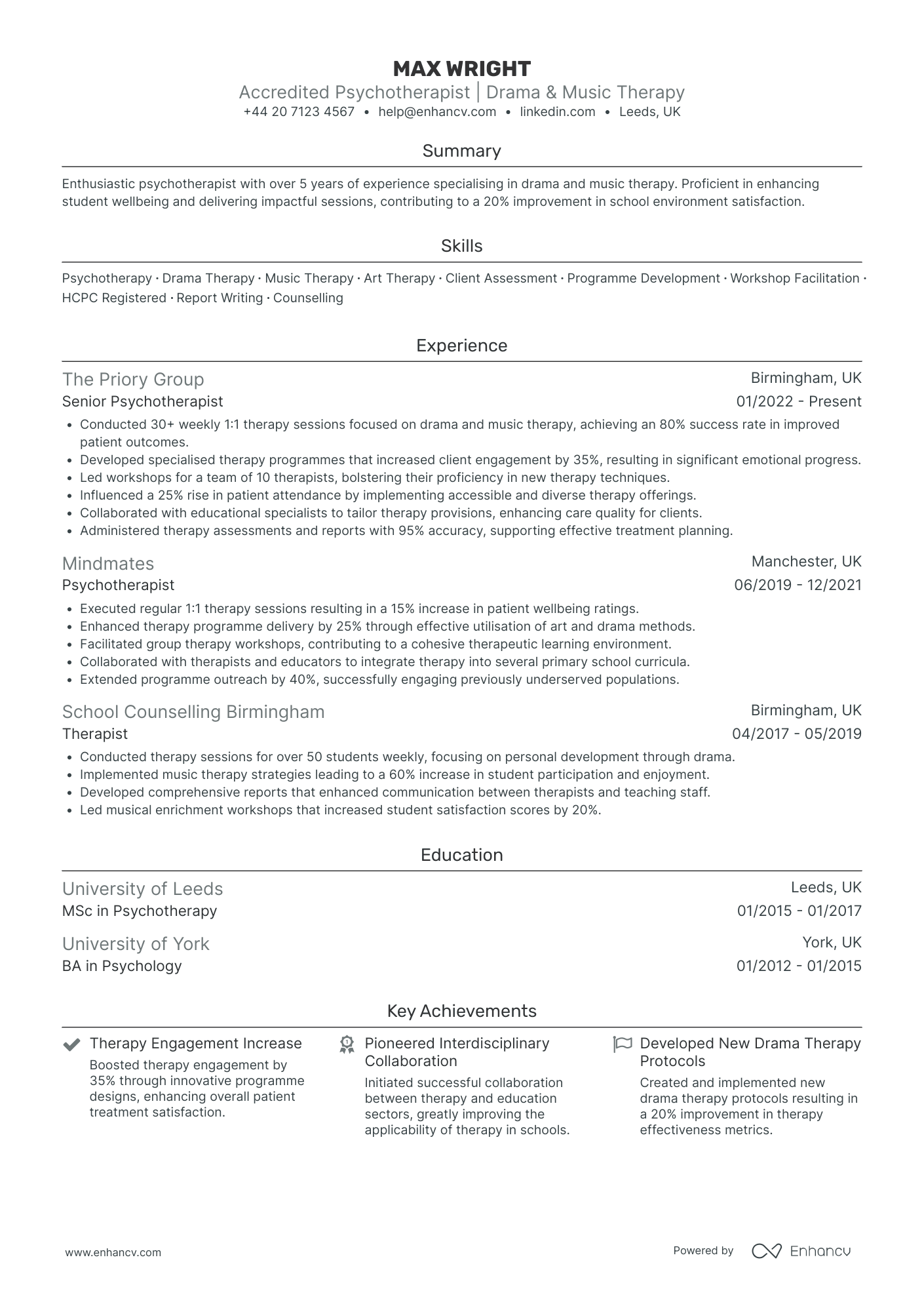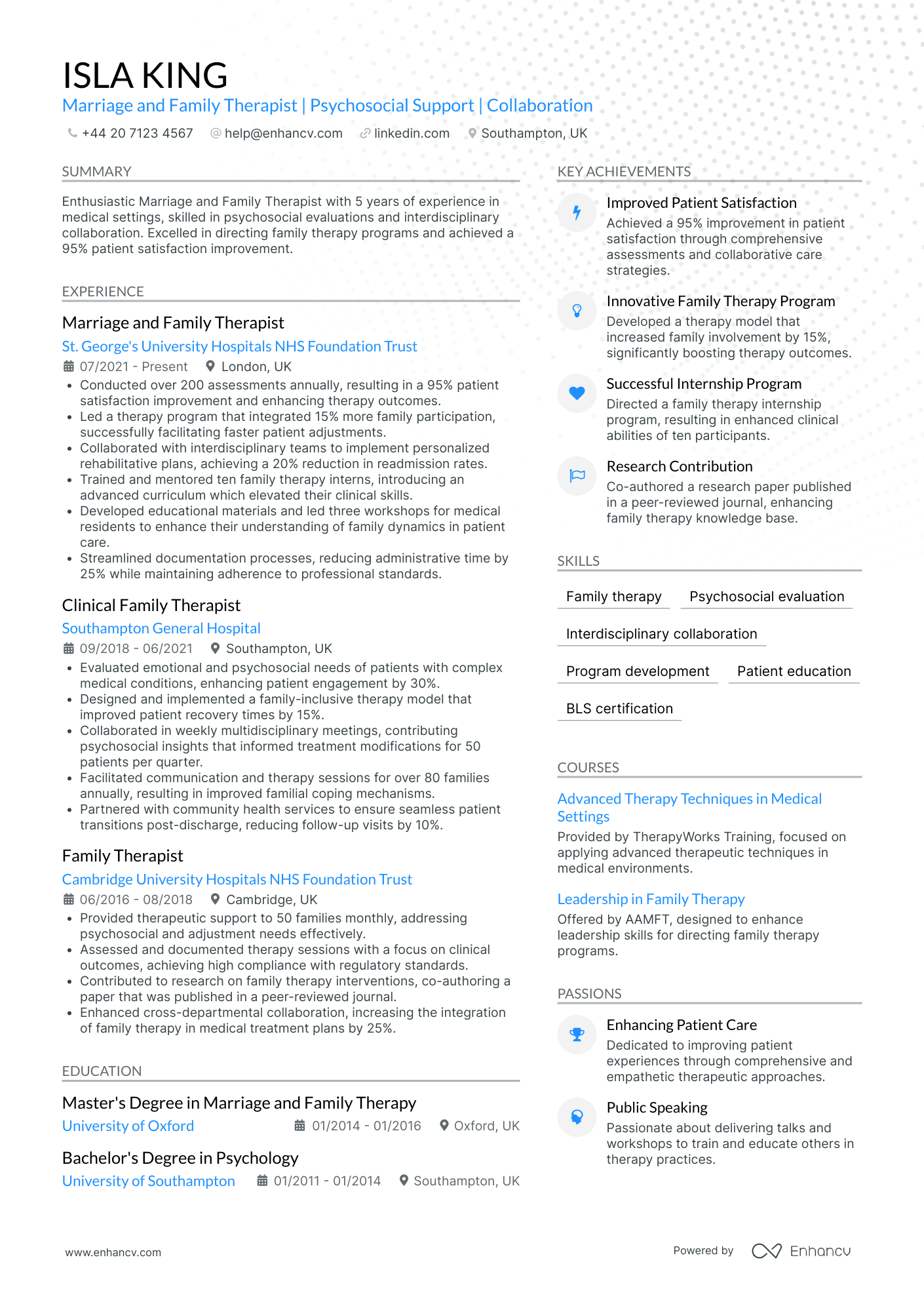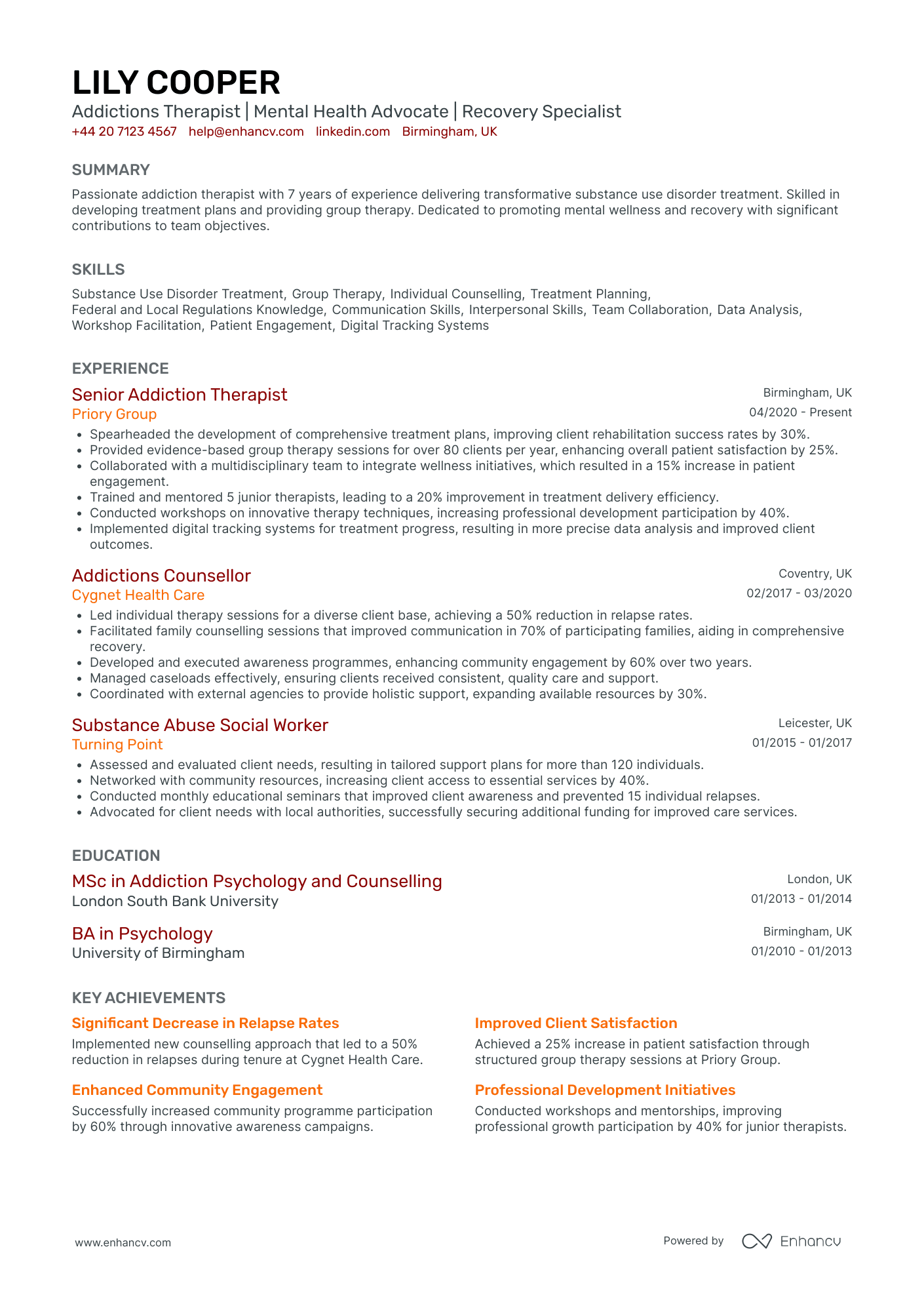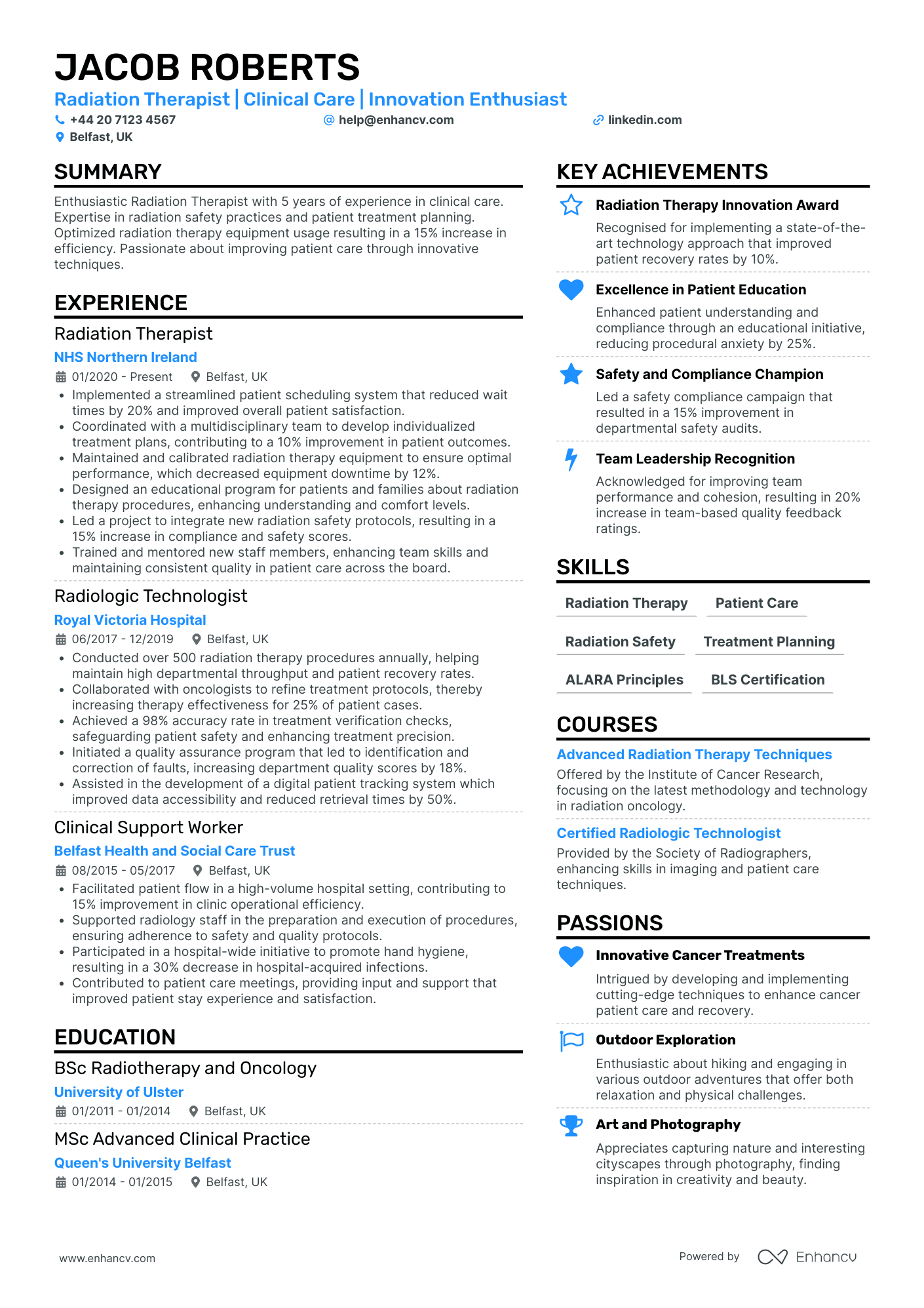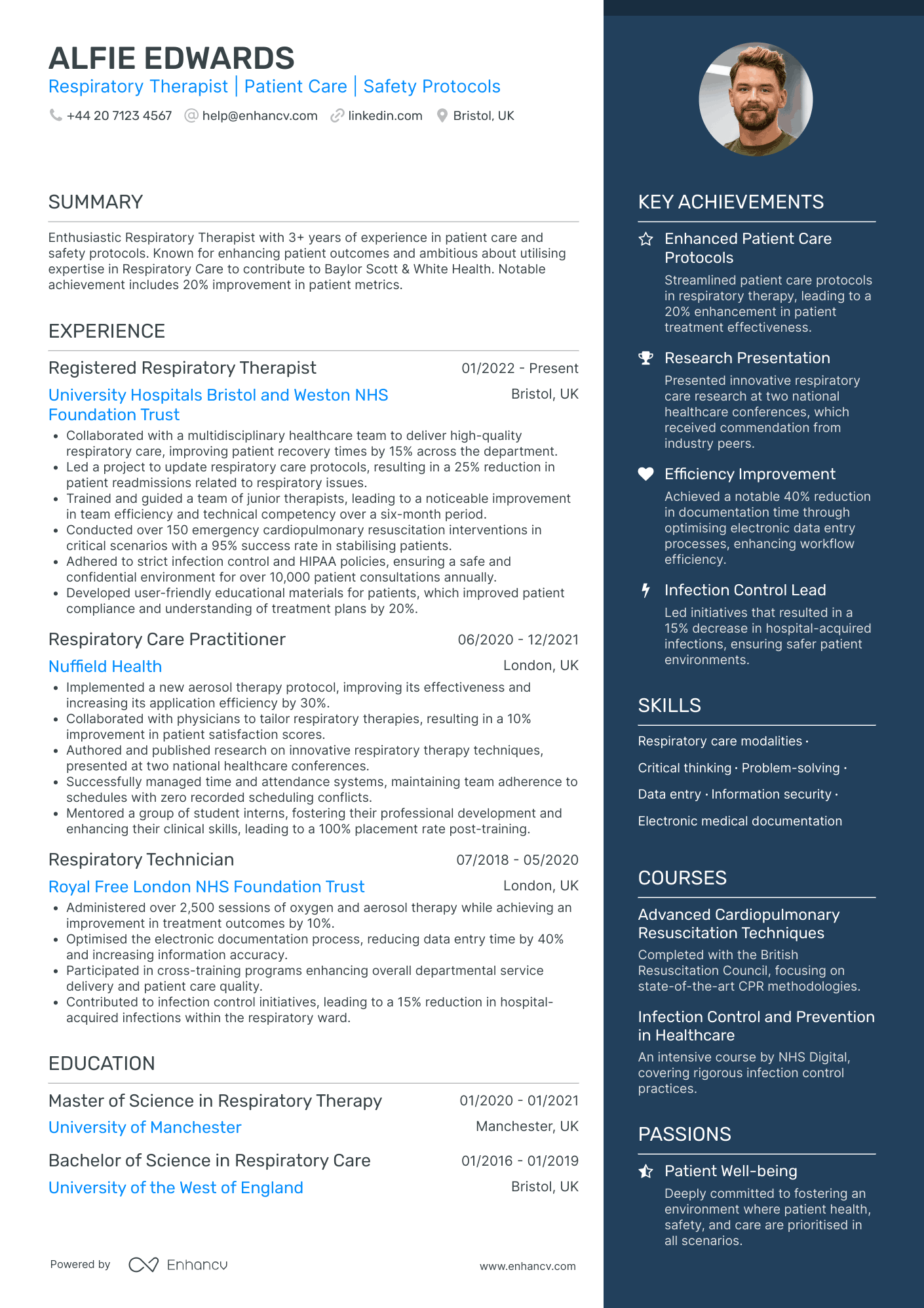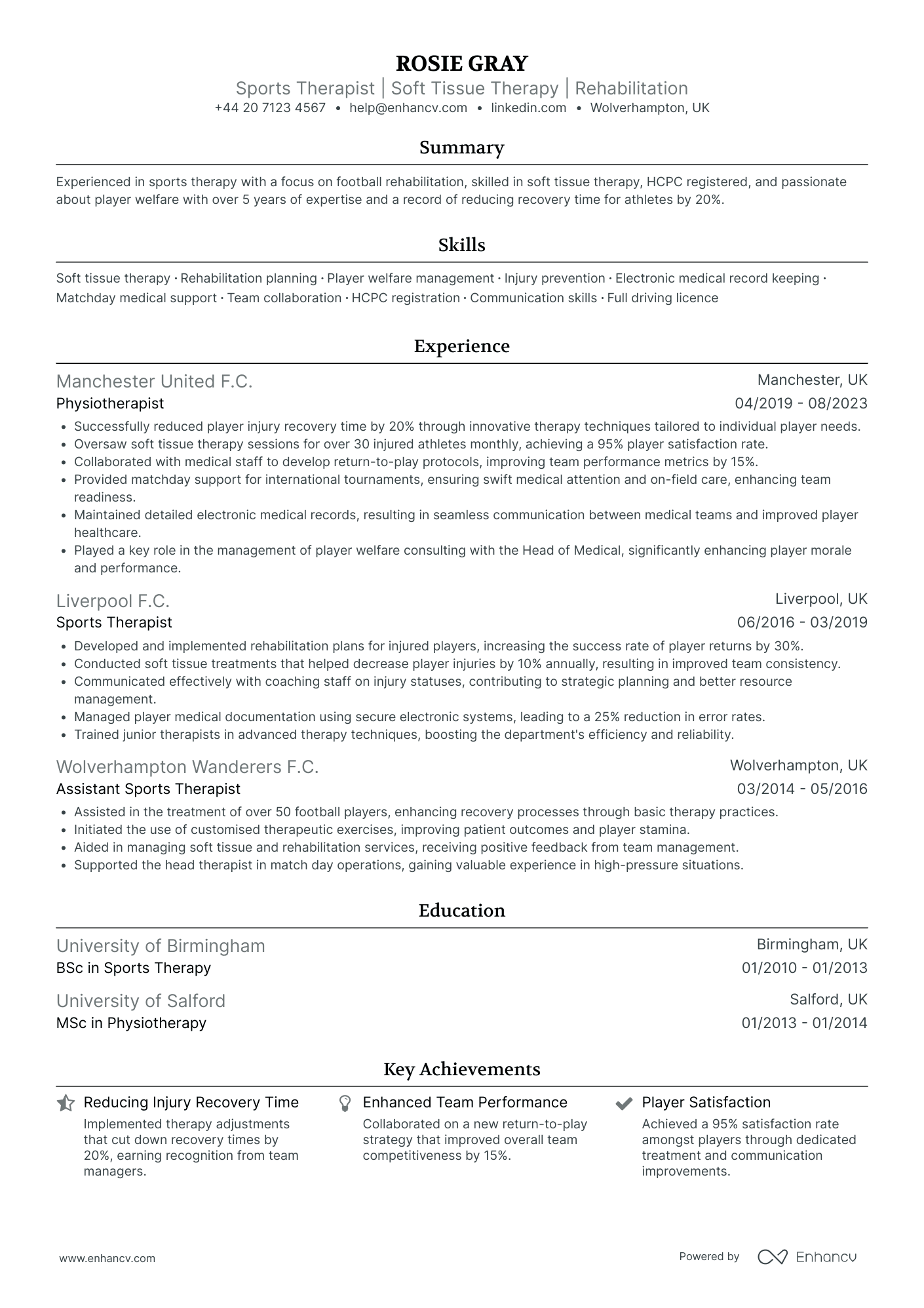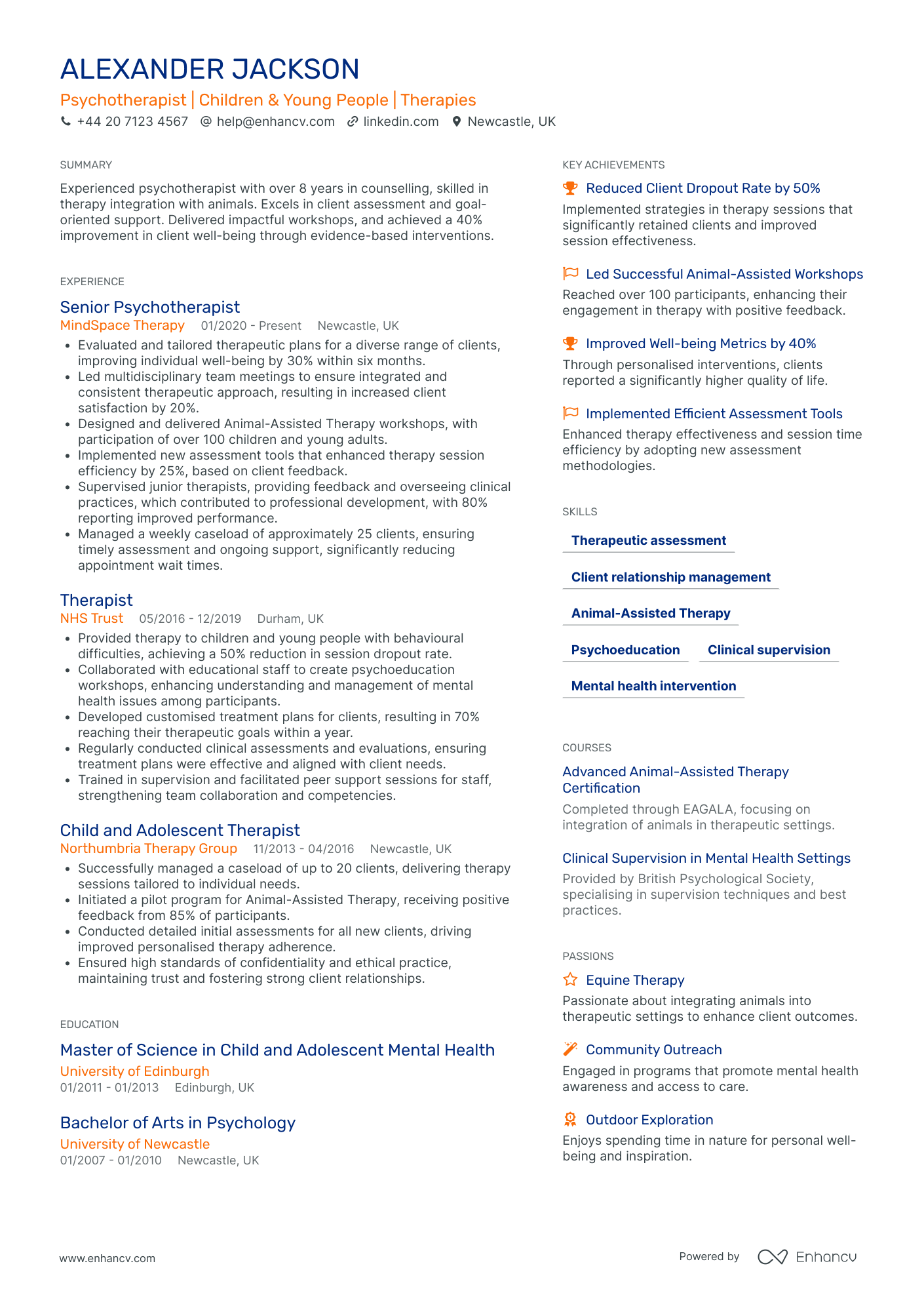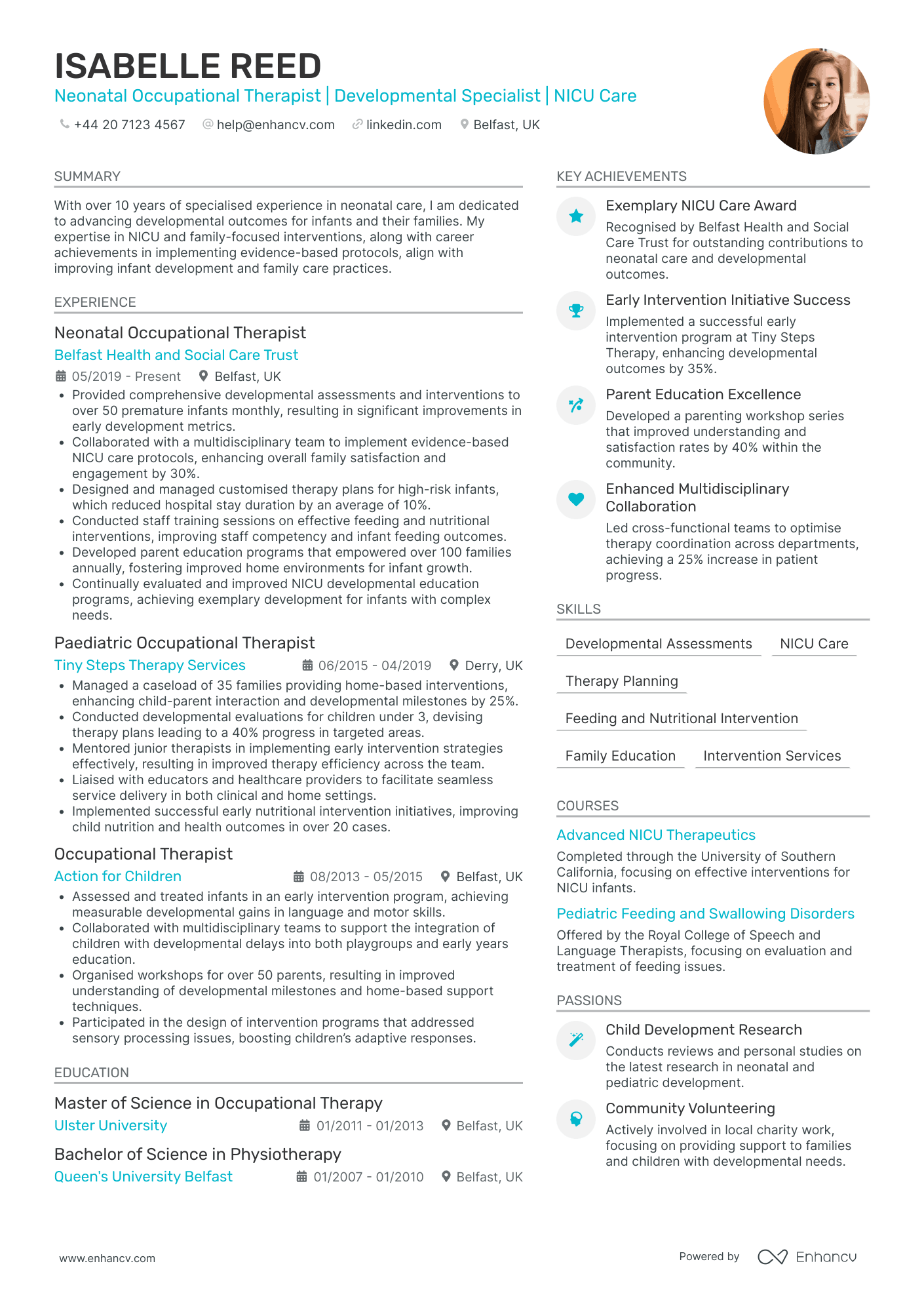One specific CV challenge faced by therapists is showcasing the range of interpersonal skills and professional experiences unique to their practice in a concise yet impactful manner. Our guide can help you distil the essence of your therapeutic expertise into a compelling CV that resonates with employers and clients alike.
- Design and format your professional therapist CV;
- Curate your key contact information, skills, and achievements throughout your CV sections;
- Ensure your profile stays competitive by studying other industry-leading therapist CVs;
- Create a great CV even if you happen to have less professional experience, or switching fields.
When writing your therapist CV, you may need plenty of insights from hiring managers. We have prepared industry-leading advice in the form of our relevant CV guides.
CV examples for therapist
By Experience
Lead Physical Therapist
- Comprehensive Structure and Clarity - Freya Richardson's CV presents information in a logically structured and clear format. Key sections such as experience, education, achievements, and skills are distinct yet interconnected, making it easy to navigate the document. Each section is concise, with bullet points enhancing readability by summarizing complex information effectively.
- Impressive Career Trajectory - Freya's career progression is notable for its upward trajectory, moving from an Orthopedic Physical Therapist to a Lead Physical Therapist role. This progression not only demonstrates her commitment to career growth but also highlights her capability to take on increasing responsibilities within the orthopedic care domain.
- Impactful Achievements with Business Relevance - The CV effectively communicates the practical impact of Freya's work through quantifiable achievements. For instance, reducing patient recovery times by 25% and boosting team performance by 25% underscore the tangible benefits she brings, aligning her individual goals with organizational performance improvements.
Head of Speech and Language Therapy
- Impressive Career Progression - The CV outlines a clear trajectory of career advancement, spotlighting Sophia's rise from a Speech and Language Therapist at Barnardo’s Scotland to her current role at The Communication Trust. Her progression to the Lead Speech and Language Therapist at NHS Greater Glasgow and Clyde highlights her capacity for growth, leadership, and her expanding impact within the industry over the years.
- Commitment to Professional Development - The inclusion of specialized courses, such as the Advanced Autism Specialist Training and Innovative Therapy Approaches, underscores Sophia's dedication to staying current with industry developments. These courses showcase her commitment to enhancing her expertise in key areas relevant to her role, ultimately contributing to her effectiveness as a therapist and supervisor.
- Impactful Achievements with Tangible Outcomes - Sophia’s CV details achievements that go beyond numbers, providing context about the broader impact of her work. For instance, her implementation of communication strategies resulting in a 30% improvement in school-wide communication efficiency and forming award-winning therapy programs speaks to her ability to effect meaningful change in her work environment and underscore her value within the organizations she has served.
Senior Addiction Therapist
- Structured and Concise Presentation - Oliver Smith's CV is clearly structured, with distinct sections that cover all necessary areas such as experience, education, skills, and achievements. The information is presented in a clear and concise manner, making it easy for readers to quickly grasp key details about his qualifications and career history.
- Robust Career Growth and Development - The CV outlines a clear career progression from a Rehabilitation Coordinator to a Senior Mental Health Practitioner. This trajectory highlights his capability to take on more responsibility and suggests a breadth of experience across different roles within the mental health sector, showcasing adaptability and growth.
- Significant Achievements with Tangible Impact - The achievements section of the CV boasts impressive milestones, such as enhancing recovery rates by 25% and increasing patient satisfaction by 20%. These accomplishments not only provide quantitative proof of his effectiveness but also demonstrate his ability to make meaningful contributions to his workplace and the well-being of patients.
Chief Radiation Therapist
- Clear and Structured Content Presentation - Chloe Bell's CV is well-organized, providing clarity and conciseness across various sections. Each experience entry is detailed with bullet points, making it easy to digest her contributions and achievements. The structured layout helps potential employers quickly grasp her qualifications and career highlights.
- Career Trajectory and Industry-Specific Growth - The CV showcases a clear upward career trajectory, with Chloe advancing from a Radiation Therapist to a Radiation Therapy Manager. This progression indicates her growing expertise and leadership within the field of radiation therapy, underscoring her commitment to professional development and excellence in patient care management.
- Emphasis on Achievements and Business Relevance - Chloe Bell clearly articulates her achievements with industry-relevant metrics, such as improving treatment accuracy by 25% and reducing treatment errors by 30%. These accomplishments not only highlight her contributions but also underscore the impact she has made in enhancing patient outcomes and departmental efficiency.
By Role
Child Therapist
- Structured Progression in Psychotherapy - The CV clearly outlines a significant career trajectory within psychotherapy, marking a gradual progression through roles that increase in responsibility and complexity. With positions from 'Child Psychologist' to 'Senior Psychotherapist', this journey reflects growth and commitment to advancing in child and adolescent mental health.
- Emphasis on Collaborative and Innovative Therapy Practices - This CV highlights industry-specific methodologies, such as hybrid therapy models and collaborative care approaches. These strategies not only illustrate the candidate’s flexibility and adaptation to modern therapy needs but also demonstrate a commitment to improving client access and engagement through innovative practices.
- Comprehensive Communication and Leadership Skills - Throughout the CV, Rosie Gray’s experience in mentoring junior clinicians and leading teams underscores her strong leadership abilities. The success in enhancing team productivity and client satisfaction implies exceptional communication skills and the capacity to foster a supportive and efficient work environment.
Cognitive Behavioural Therapist
- Clear and Structured Presentation - The CV is exceptionally organized with sections logically laid out, making it easy to digest information quickly. The use of bullet points under each job title highlights key responsibilities and achievements succinctly, providing a comprehensive overview without overwhelming the reader.
- Demonstrates Industry Growth and Commitment - Eva's career trajectory shows a clear progression from a Mental Health Practitioner to a Senior CBT Therapist, revealing steady growth within the NHS framework. Her long tenure in mental health therapy exhibits a deep commitment to the field, particularly focusing on maternal mental health.
- Impactful Achievements with Real-World Relevance - The CV places significant emphasis on achievements that have tangible impacts. From improving recovery rates by 35% to reducing postpartum depression by 25%, each statistic is contextually tied to real-world relevance, showcasing Eva's efficacy in addressing critical health issues.
Occupational Therapist
- Structured Career Growth with Impact - Alice Barnes's CV effectively illustrates a clear career trajectory within occupational therapy, showcasing her promotion to Senior Occupational Therapist after a significant stint in junior roles. Her progression is substantiated by leadership capabilities and her dedication to improving patient outcomes, which is evident from her leading implementation of new protocols and mentoring junior staff.
- Emphasis on Community and Team Collaboration - The CV highlights a unique emphasis on cross-functional collaboration and community engagement. Through partnerships with external organizations and multidisciplinary teamwork, Alice has expanded health services to underrepresented communities, addressing healthcare disparities and demonstrating her adaptability and commitment to holistic care.
- Quantifiable Achievements and Professional Impact - Achievements within Alice's experiences are precisely detailed with quantifiable results, doubling as business relevance. Her leadership in reducing hospital readmissions by 30% and implementing patient satisfaction programs illustrates a strong focus on measurable improvements in patient care, reinforcing her strategic approach and commitment to healthcare excellence.
Physical Therapist
- Structured and Concise Presentation - The CV is effectively organized with clearly defined sections, facilitating easy navigation and ensuring that key information is accessible at a glance. Each section, from experience to education, is succinctly presented, emphasizing essential details without overwhelming the reader with unnecessary information.
- Career Growth and Leadership - Charlotte Powell's career trajectory illustrates a clear progression from Junior to Senior Physical Therapist, reflecting her growth in the field. Her leadership role is underscored by responsibilities such as supervising a team and leading departmental workshops, indicating her ability to oversee and direct high-level patient care initiatives.
- Effective Use of Metrics - The CV highlights significant achievements using concrete metrics, such as a 30% improvement in patient recovery outcomes. This quantitative approach not only demonstrates her expertise in driving tangible results but also showcases her impact on patient care and departmental efficiency, aligning with the strategic objectives of healthcare organizations.
Speech and Language Therapist
- Clear and Structured Content Presentation - The CV is well-organized and concise, allowing key information about Henry White's qualifications and experience to be easily absorbed. Each section is clearly defined, and bullet points are used effectively to highlight specific achievements and responsibilities, ensuring clarity and readability.
- Demonstrates Continuous Career Growth - Henry's career trajectory showcases significant progression from a Junior Speech & Language Therapist to a specialist role, reflecting his dedication and capability. This upward movement within the healthcare sector, accompanied by experience in multiple reputable institutions, highlights his growing expertise and reputation.
- Focus on Industry-Specific Skills and Tools - The CV spotlights specialized skills in dysphagia management and voice disorder treatment, crucial for a Speech & Language Therapist. His initiatives and protocol developments demonstrate a deep technical understanding and the ability to apply theoretical knowledge to practical challenges, which are essential in his field.
Art Therapist
- Strategic Career Progression - Ella Bennett's career trajectory demonstrates a clear upward progression from an Art Psychotherapist at Mindful Kids to a Senior Art Psychotherapist at CAMHS NHS Foundation Trust, and currently as an Art Therapist at The Hummingbird Project. This growth indicates her increasing expertise and the recognition of her skills in more responsible roles.
- Integration of Creative and Clinical Expertise - Ella’s CV shows a unique blend of creative arts and therapy through roles focusing on art therapy. The methodologies and tools mentioned, such as creating tailored therapy sessions and implementing new creative arts therapies, highlight an innovative, industry-specific approach that addresses mental health challenges effectively.
- Leadership and Influence - Leadership capabilities are strongly evident in Ella’s work, particularly through her achievements like leading a team to increase patient engagement by 40%. Her roles have required her to act in influential capacities, guiding junior therapists and participating in interdisciplinary teams, thus reflecting her leadership and mentoring skills.
Music Therapist
- Strategic Career Growth - Freddie Hughes's CV showcases a robust career trajectory that reflects progressive responsibility and a move towards leadership. Beginning as a Music Therapist, Freddie's advancement to Senior Therapist at Starlight Children's Foundation exemplifies a commitment to elevating the quality of therapeutic services provided.
- Integration of Innovative Techniques - The CV highlights Freddie's dedication to incorporating digital tools in therapy, something not universally adopted in the therapy field. The implementation of new digital music resources to increase remote session accessibility shows an innovative approach to overcoming logistical barriers.
- Impactful Achievements - The document is reinforced by impactful achievements such as receiving the 'Therapist of the Year' award and significantly improving service feedback and participation metrics. These accomplishments underline Freddie's ability to enact meaningful changes that enhance therapy programs' effectiveness.
Drama Therapist
- Clear and Structured Presentation - The CV is well-organized with clear sections that make it easy to navigate. The content is concise yet comprehensive, providing all necessary details such as positions held, responsibilities, and achievements without overwhelming the reader.
- Strong Career Trajectory - Max Wright's career shows significant growth and progression. Starting as a Therapist at School Counselling Birmingham, they advanced to a Senior Psychotherapist at The Priory Group, indicating a clear path of promotions and increased responsibilities, underlining career development and commitment to the field.
- Integration of Unique Therapeutic Techniques - The use of drama and music therapy as highlighted in the CV demonstrates industry-specific methodologies that are not only distinct but also innovative. These techniques reflect Max Wright's expertise in applying creative arts for therapeutic purposes, which sets them apart in the psychotherapy field.
Marriage and Family Therapist
- Structured Presentation and Clarity - The CV is exceptionally well-structured, making it easy to follow the progression of Isla King's career. Each section is clearly defined, with concise content that highlights key responsibilities and achievements, allowing a quick yet comprehensive understanding of her professional journey.
- Demonstrated Career Growth and Specialization - The career trajectory outlined in the CV reflects a clear path of growth within the field of therapy, with progressive roles at reputable institutions. This evolution from Clinical Family Therapist to a more integrated role demonstrates her increasing responsibility and expertise, culminating in her current position with a clear emphasis on innovation and leadership.
- Industry-Specific Methodologies and Impact - The CV highlights Isla King's use of advanced therapy techniques and innovative therapy program development, tailored for medical environments. The specific mention of contributing to a reduction in readmission rates and improving recovery times underlines her practical impact on patient care and healthcare outcomes.
Addiction Therapist
- Strategic Presentation and Structure - The CV is meticulously organized, starting with a comprehensive summary that immediately establishes Lily Cooper's specialization in addiction therapy and mental health advocacy. Each section follows logically, ensuring clarity and conciseness, which makes it easy for potential employers to navigate and understand her qualifications and accomplishments.
- Robust Career Trajectory - The career path outlined in the CV shows significant growth from a Substance Abuse Social Worker to a Senior Addiction Therapist, highlighting promotions and increasing responsibilities. This upward trajectory within reputable organizations underscores her expertise and commitment to the field of addictions therapy.
- Comprehensive Treatment Expertise - Lily Cooper's CV showcases her deep technical knowledge in addiction treatment, particularly through her experience in developing treatment plans, conducting evidence-based group therapies, and utilizing digital tracking systems. These are crucial for driving successful rehabilitation outcomes, demonstrating her industry-specific competence and innovative approach.
Radiation Therapist
- Structured Clarity with Conciseness - The CV stands out in its clear and structured presentation with concise bullet points that effectively highlight Jacob's professional achievements. Each section is well-organized with distinct headings, facilitating easy navigation and understanding of his career journey and expertise.
- Proven Growth and Industry Advancement - Jacob's career trajectory highlights a clear progression from Clinical Support Worker to Radiation Therapist, demonstrating a commitment to professional growth and mastery within the healthcare industry. His move through positions at reputable institutions like the NHS and Royal Victoria Hospital underscores his dedication to advancing in the field.
- Leadership and Soft Skills Excellence - The CV emphasizes Jacob's leadership abilities and teamwork skills through experiences such as training new staff, leading projects, and coordinating with multidisciplinary teams. His role in enhancing team performance and implementing new initiatives showcases his capacity to lead and mentor effectively.
Respiratory Therapist
- Structured Presentation with Contextual Relevance - The CV is expertly structured, providing a clear and concise overview of Alfie Edwards’ professional achievements and competencies relevant to a Respiratory Therapist role. Each section is well-organized with bullet points that enhance readability, ensuring key achievements and skills are easily identifiable and effectively communicated to the reader.
- Diverse Career Growth Reflects Industry Commitment - Alfie’s career trajectory showcases steady growth within the healthcare industry, progressing from a Respiratory Technician to a Registered Respiratory Therapist. This advancement illustrates a dedication to professional development and a consistent focus on respiratory care, underlined by obtaining higher education degrees and active participation in pertinent professional courses.
- Emphasis on Cross-Functional Experience - The CV highlights Alfie's adaptability and cross-functional expertise, evidenced by collaborations with multidisciplinary teams to improve patient recovery processes. The work with educational materials and protocol development displays an ability to bridge clinical skills with educational initiatives, fostering improved patient compliance and staff training outcomes.
Sports Therapist
- Clear and cohesive content presentation - Rosie's CV is structured in a concise manner, allowing for easy navigation through her professional history and qualifications. The use of specific bullet points under each job experience highlights key achievements and responsibilities without overwhelming the reader.
- Steady career progression in the sports therapy field - Over the span of nearly a decade, Rosie has advanced from an Assistant Sports Therapist to significant roles at prestigious football clubs like Manchester United F.C. and Liverpool F.C. This trajectory demonstrates her commitment and growth within the sports therapy field.
- Industry-specific expertise in sports rehabilitation - Rosie's CV emphasizes her specialization in sports therapy, particularly within football. Her knowledge in soft tissue therapy and rehabilitation techniques, combined with HCPC registration, indicates a deep technical proficiency that is vital for handling high-performance athletes.
Animal-Assisted Therapist
- Structured and Clear Presentation - The CV is well-organized, featuring clearly defined sections and a concise summary that directly highlights the candidate's extensive experience in psychotherapy. The bullet points under each job position clearly articulate key responsibilities and achievements, making it easy to glean essential information quickly.
- Dynamic Career Progression - The career trajectory demonstrates significant growth and development, with Alexander moving from a Child and Adolescent Therapist position to a Senior Psychotherapist. This progression indicates a deepening of expertise and increased responsibility over time, reflecting commitment and competence in the field.
- Specialization in Animal-Assisted Therapy - Notably, the inclusion of Animal-Assisted Therapy as a unique skill set and area of interest highlights Alexander's specialized approach to psychotherapy, setting them apart from peers in more traditional therapy settings. This expertise is supported by specific certifications and demonstrated impact through successful workshops and initiatives.
Neonatal Therapist
- Strategically structured content with clear progression - Isabelle's CV is structured to provide clarity and conciseness, with sections clearly highlighting her roles, responsibilities, and achievements. This order allows potential employers to quickly grasp her career journey and expertise in neonatal occupational therapy, making her qualifications stand out at a glance.
- Demonstrates a strong career growth trajectory - Throughout her career, Isabelle has consistently moved forward, enhancing her skill set and taking on more responsibilities. She progressed from an Occupational Therapist to a Neonatal Occupational Therapist, indicating her dedication to specializing in neonatal care and her drive for professional growth within her field.
- Achievements indicate significant business impact - Each role Isabelle has taken reflects notable achievements with clear outcomes, such as reduced hospital stays and increased family satisfaction in the NICU. These accomplishments highlight her effectiveness and demonstrate her capacity to implement improvements that greatly benefit both the healthcare setting and patient outcomes.
Structuring and formatting your therapist CV for an excellent first impression
The experts' best advice regarding your CV format is to keep it simple and concise. Recruiters assessing your CV are foremost looking out for candidates who match their ideal job profile. Your white space, borders, and margins. You may still be wondering which format you need to export your CV in. We recommend using the PDF one, as, upon being uploaded, it never alters your information or CV design. Before we move on to the actual content of your therapist CV, we'd like to remind you about the Applicant Tracker System (or the ATS). The ATS is a software that is sometimes used to initially assess your profile. Here's what you need to keep in mind about the ATS:
- All serif and sans-serif fonts (e.g. Rubik, Volkhov, Exo 2 etc.) are ATS-friendly;
- Many candidates invest in Arial and Times New Roman, so avoid these fonts if you want your application to stand out;
- Both single and double column CVs can be read by the ATS, so it's entirely up to you to select your CV design.

PRO TIP
Incorporate a touch of colour in headers or section breaks, but keep it professional and ensure it doesn’t detract from readability, especially in more conservative industries.
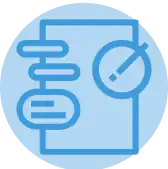
The top sections on a therapist CV
- Clinical Experience shows years of patient interactions.
- Relevant Qualifications highlight essential therapy education.
- Professional Registrations confirm legitimacy and standards.
- Therapy Specialities showcase areas of expertise and focus.
- Supervisory Experience denotes leadership and mentor skills.
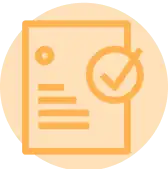
What recruiters value on your CV:
- Emphasise your credentials by including your relevant degrees, certifications, and professional association memberships, as these qualifications are often prerequisites for practising therapy.
- Detail your experience with specific modalities or therapeutic approaches, such as CBT, DBT, or psychodynamic therapy, to showcase your expertise and compatibility with potential employer needs.
- Highlight your soft skills, such as empathy, active listening, and strong communication abilities, which are critical in building rapport and effectively helping clients.
- Include any specialties or populations you are particularly skilled in working with, such as children, those with trauma, or individuals with specific mental health challenges.
- Provide concrete examples of successful interventions or outcomes from your practice to demonstrate the impact of your work on clients' wellbeing.
Recommended reads:
Making a good first impression with your therapist CV header
Your typical CV header consists of Your typical CV header consists of contact details and a headline. Make sure to list your professional phone number, email address, and a link to your professional portfolio (or, alternatively, your LinkedIn profile). When writing your CV headline , ensure it's:
- tailored to the job you're applying for;
- highlights your unique value as a professional;
- concise, yet matches relevant job ad keywords.
You can, for examples, list your current job title or a particular skill as part of your headline. Now, if you decide on including your photo in your CV header, ensure it's a professional one, rather than one from your graduation or night out. You may happen to have plenty more questions on how to make best the use of your CV headline. We'll help you with some real-world examples, below.

Examples of good CV headlines for therapist:
- "Clinical Psychologist | Child and Adolescent Therapy | CBT Specialist | HCPC Registered | 8 Years' Experience"
- "Family Therapist | Systemic Practices | Relationship Dynamics Expert | AFT Certified | 5+ Years in Practice"
- "Psychotherapist | Trauma and Anxiety Focus | Integrative Approach | BACP Accredited | 10 Years Clinical Experience"
- "Counselling Psychologist | Mental Health and Wellbeing Advocate | PhD | Chartered Psychologist | 15+ Years Professional"
- "Addiction Counsellor | Substance Abuse and Recovery | 12-Step Programme Facilitator | 3 Years Dedicated Support"
- "Occupational Therapist | Rehabilitation and Inclusion | Sensory Integration Specialist | HCPC Registered | 7 Years' Expertise"
Catching recruiters' attention with your therapist CV summary or objective
Located closer to the top of your CV, both the summary and objective are no more than five sentences long and serve as an introduction to your experience. What is more, you could use either to entice recruiters to read on. Select the:
- Summary, if you happen to have plenty of relevant experience. Feature your most impressive accomplishments and up to three skills that are relevant to the job you're applying for;
- Objective, if you're just starting your career off. Provide your career goals and answer how you see the role you are applying for will match your professional growth.
Judging which one you need to add to your therapist CV may at times seem difficult. That’s why you need to check out how professionals, with similar to your experience, have written their summary or objective, in the examples below:

CV summaries for a therapist job:
- With over a decade of dedicated service as a licensed clinical psychologist, I possess a rich tapestry of experience assisting clients through cognitive behavioural therapy and crisis intervention. My tenure includes developing a renowned mindfulness-based stress reduction programme that significantly elevated patient outcomes.
- Adept in delivering compassionate care, with 7 years of experience as a family therapist, I have refined my expertise in systemic therapy, fostering resilience and emotional well-being among diverse clientele. My distinguished accomplishment includes spearheading a community outreach programme that reduced therapy access disparities.
- Transitioning from a 10-year career as a seasoned educator, I bring a unique amalgamation of skills in communication, conflict resolution, and group facilitation. Excited to leverage this background, I am eager to enrich the therapeutic landscape with innovative support strategies tailored to individual learning preferences.
- Fusing a 15-year journey in human resource management with a recent postgraduate diploma in psychotherapy, I am enthusiastic about utilising my robust understanding of organisational dynamics and employee wellness to foster therapeutic relationships centred around personal growth and professional development.
- As a recent master's graduate in counselling psychology and with a thorough grounding in psychoanalytic and humanistic modalities through my academic training, I am committed to initiating my career by contributing to the emotional well-being of clients. My goal is to facilitate healing and self-discovery within a supportive therapeutic environment.
- Embarking upon a new professional path in therapy, having completed a comprehensive bachelor's programme in social work, my objective is to integrate my robust interpersonal skills and foundational knowledge of mental health to provide empathetic, evidence-based support to individuals across various stages of life.
How to meet job requirements with your therapist CV experience
We've now reached the essence of your actual CV - your experience section. This is the space where you can list your career roles and on-the-job successes. Many candidates tend to underestimate just how much time and effort they should put into writing this CV section. Your experience shouldn't be a random list of your responsibilities, but instead:
- Match the job description with your skills, values, and accomplishments;
- Start each bullet with a strong action verb, followed up with one key skill and your outcome of applying this skill;
- Spotlight parts of your career history that are relevant to the job you're applying for.
Before we move on, make sure to check out some professional CV experience sections.

Best practices for your CV's work experience section
- Utilised a wide range of therapeutic modalities, including CBT, DBT, and psychodynamic approaches, to tailor treatment plans for individual client needs.
- Conducted initial assessments for over 200 clients, meticulously collecting client histories and presenting concerns to inform treatment direction.
- Facilitated weekly group therapy sessions for clients dealing with anxiety and depression, creating a supportive environment to foster shared healing and growth.
- Collaborated with multidisciplinary teams including psychiatrists, GPs, and social workers to provide comprehensive care and ensure continuity in clients' mental health support.
- Implemented evidence-based interventions to support clients with trauma histories, achieving significant improvements in PTSD symptomatology as measured by the PCL-5.
- Maintained detailed client records with the utmost confidentiality, adhering to GDPR and professional ethical standards regarding data protection and client privacy.
- Created and delivered psychoeducation workshops in community settings aimed at raising awareness of mental health issues such as anxiety disorders and coping strategies.
- Successfully navigated a caseload of up to 30 clients per week, demonstrating strong organisational skills and the ability to prioritise therapeutic needs effectively.
- Engaged in over 100 hours of continued professional development activities annually, staying abreast of the latest research and advances in clinical psychology and therapy techniques.
- Implemented a client-centred therapeutic approach that improved patient satisfaction scores by 20% within the first year.
- Collaborated with a multi-disciplinary team to develop and launch a wellness program that served over 500 clients with positive feedback.
- Utilised evidence-based practices to enhance treatment efficacy, reducing average client recovery time by 25%.
- Managed a caseload of 40+ clients per week, providing individualised treatment plans that led to a 30% improvement in client mental health.
- Provided crisis intervention services, resulting in a 15% reduction in emergency incidents amongst the client group.
- Delivered training workshops to 100+ healthcare professionals on cognitive behavioural therapy techniques and their application.
- Spearheaded a research project on the effectiveness of mindfulness therapy, which was subsequently published in a peer-reviewed journal.
- Conducted group therapy sessions for adolescents, resulting in a 40% decrease in reported symptoms of depression and anxiety.
- Developed a teletherapy program that expanded service access to remote clients, leading to a 20% increase in clinic revenue.
- Introduced an innovative art therapy program to the clinic, enhancing patient expressive capabilities and aiding in the treatment of 150+ patients.
- Trained 25+ interns in patient communication and therapeutic techniques, ensuring high-quality service delivery across the clinic's offerings.
- Created comprehensive treatment plans that integrated patient feedback and preferences, increasing patient compliance by 35%.
- Instrumental in the development of a digital therapy platform, which broadened client accessibility and led to a 50% rise in client engagement.
- Engaged and supported clients through the development of a patient advocacy program, which improved patient outcomes and clinic reputation.
- Authored a series of client-centred resources that were utilised by over 200 patients to self-manage their mental health.
- Achieved a high success rate in treatment adherence by incorporating motivational interviewing techniques tailored to individual patient motivations.
- Successfully engaged with hard-to-reach client demographics, increasing the clinic's outreach effectiveness by 30%.
- Pioneered a peer support program that improved long-term treatment outcomes for 80% of participants.
- Designed and facilitated a specialised therapy program for veterans, which helped over 100 individuals reintegrate successfully into civilian life.
- Coordinated with local health authorities to increase funding for mental health services by presenting successful case studies from our clinic's work.
- Pioneered the use of virtual reality therapy at the clinic, enhancing treatment options for clients with PTSD.
- Enhanced interdepartmental communication pathways by 40% through the introduction of a unified case management system, resulting in improved patient care coordination.
- Led a team that developed and implemented a holistic therapy program that saw a 25% increase in positive patient outcomes compared to standard treatment protocols.
- Oversaw the integration of biofeedback mechanisms into treatment plans, increasing the precision of therapeutic interventions.
How to ensure your therapist CV stands out when you have no experience
This part of our step-by-step guide will help you substitute your experience section by helping you spotlight your skill set. First off, your ability to land your first job will depend on the time you take to assess precisely how you match the job requirements. Whether that's via your relevant education and courses, skill set, or any potential extracurricular activities. Next:
- Systematise your CV so that it spotlights your most relevant experience (whether that's your education or volunteer work) towards the top;
- Focus recruiters' attention to your transferrable skill set and in particular how your personality would be the perfect fit for the role;
- Consider how your current background has helped you build your technological understanding - whether you've created projects in your free time or as part of your uni degree;
- Ensure you've expanded on your teamwork capabilities with any relevant internships, part-time roles, or projects you've participated in the past.
Recommended reads:

PRO TIP
If applicable, briefly mention a situation where things didn’t go as planned and what you learned from it, demonstrating your ability to learn and adapt.
Describing your unique skill set using both hard skills and soft skills
Your therapist CV provides you with the perfect opportunity to spotlight your talents, and at the same time - to pass any form of assessment. Focusing on your skill set across different CV sections is the way to go, as this would provide you with an opportunity to quantify your achievements and successes. There's one common, very simple mistake, which candidates tend to make at this stage. Short on time, they tend to hurry and mess up the spelling of some of the key technologies, skills, and keywords. Copy and paste the particular skill directly from the job requirement to your CV to pass the Applicant Tracker System (ATS) assessment. Now, your CV skills are divided into:
- Technical or hard skills, describing your comfort level with technologies (software and hardware). List your aptitude by curating your certifications, on the work success in the experience section, and technical projects. Use the dedicated skills section to provide recruiters with up to twelve technologies, that match the job requirements, and you're capable of using.
- People or soft skills provide you with an excellent background to communicate, work within a team, solve problems. Don't just copy-paste that you're a "leader" or excel at "analysis". Instead, provide tangible metrics that define your success inusing the particular skill within the strengths, achievements, summary/ objective sections.
Top skills for your therapist CV:
Psychotherapy
Cognitive Behavioural Therapy (CBT)
Family Systems Therapy
Play Therapy
Group Therapy Facilitation
Crisis Intervention
Treatment Planning
Psychological Assessment
Mental Health Counselling
Behavioural Modification Techniques
Active Listening
Empathy
Communication
Patience
Problem-Solving
Adaptability
Professionalism
Confidentiality
Cultural Sensitivity
Self-Reflection

PRO TIP
Use mini case studies or success stories in your CV to demonstrate how your skills have positively impacted previous roles or projects.
CV education and certificates: your academic background as proof of your skill set
A common misconception about your therapist CV education is that you only need it, if you have less professional experience. That is completely false. The CV education section serves to back up your technical (and sometimes personal) capabilities, fill in gaps in your work history, and show you have the initial industry background and know-how. When creating your education section:
- List your degrees in the reverse chronological order, starting with the most recent (and relevant) ones first;
- Include your degree and university names, start and graduation dates. It's optional to also denote you received a "First-Class Honours" for diplomas that are more relevant to the role;
- Curate your relevant university coursework, projects, or thesis work if you happen to have less professional expertise and need to integrate more job keywords and skills.
Your professional qualifications don't need to stop at your academic background. It's advisable to also select up to three of your most noteworthy (and relevant) industry certificates and feature them in a dedicated section. Once more, include the certificate name, the institution that issued it out, and the date you obtained it on. You could feature both hard skills and soft skills certificates, as in the examples below:

PRO TIP
Focus on describing skills in the context of the outcomes they’ve helped you achieve, linking them directly to tangible results or successes in your career.
Recommended reads:
Key takeaways
Here are five things you need to remember about writing your therapist CV for success:
- Sort your experience based on the reverse chronological order, starting with your most recent career items, to showcase how you've grown your career;
- Include within your CV header your relevant contact details, a headline that could spotlight your unique value, and a photo - if you're applying for roles outside the UK or US;
- Decide to use the CV summary, if you happen to have more professional experience, and an objective, if you want to showcase your career goals;
- Within the experience section, write your bullets using action verbs, skills, and success, instead of just merely listing your on-the-job responsibilities;
- Prove your technical skills, using your education and certificates, and your soft skills, with your achievements and strengths sections.

